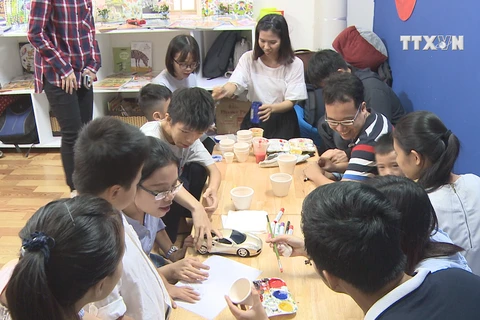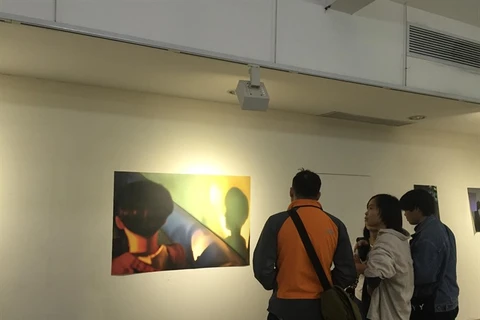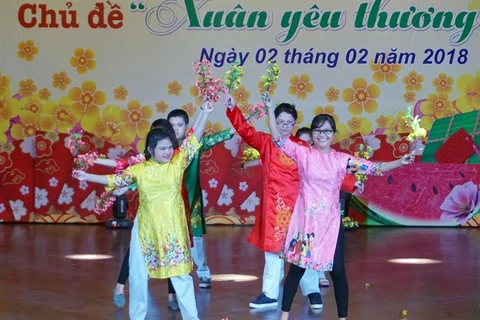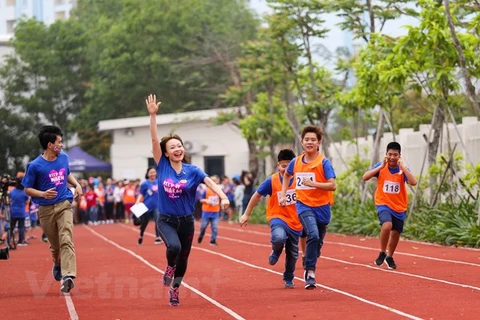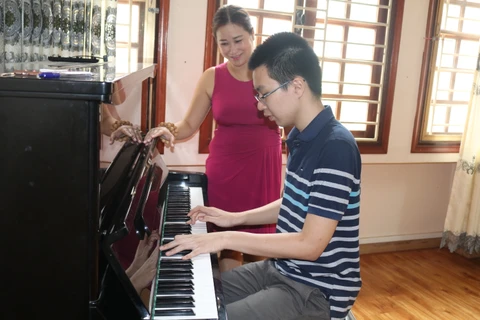Hanoi (VNA) – No official survey has been conducted to count the number of autistic children in Vietnam yet, but the Ministry of Labour, Invalids and Social Affairs estimates that some 200,000 children in the country are living with autism.
The figure would reach 500,000 according to the standards of the World Health Organisation.
Open your heart to children with autism
“If you open your heart to children with autism, you will see they are not necessarily mentally disordered. In fact, many have a higher level of intelligence than the average child and some have extraordinary capabilities in different fields, such as memory, maths, art and physics,” said Pham Thi Ngan.
Ngan and her husband Nguyen Dinh Nguyen were inspired by the capabilities of those on the autism spectrum after they volunteered for international organisations that raise public awareness of autism in Vietnam.
They founded the Hanoi-based Tohe Social Company, which encourages disadvantaged children to express themselves via art and then benefit from their creative products.
“We saw the economic values of the art works created by artists with autism,” Ngan told Vietnam News Agency.
“We set up Tohe to connect the autistic persons’ talents and skills to the huge-potential creative industry.”
Ngan was listed among 121 Global Young Leaders by the World Economic Forum in 2016 for her humanitarian initiative.
Tohe has ran a wide range of social activities over the past 12 years for children with disadvantaged backgrounds, including those on the autism spectrum.
It organised the “Iuiuiu” (cute) exhibition with paintings and sculptures made by children with autism, and three workshops in April to consult parents of children with autism and raise public awareness of autism.
“We (WAD members) share the passion of befriending, assisting and playing with people with autism,” Dang Thuy Hong, WAD leader and founder told VNA.
Since its establishment in September 2016, WAD has organised 64 activities and playgrounds for autistic kids to play, create art and connect with the community.
In 2017, the WAD hosted a “Free Hugs” campaign to help autistic kids connect with each other and the community.
It also launched WAD Library, the first in HCM City for autistic youths in the year. The library was funded by the Institute for Studies of Society, Economics and Environment (iSEE), a non-governmental organisation.
“The library aims to provide a safe reading and teaching space and sources for autistic kids and youths,” said Hong.
Many children with autism in Ho Chi Minh City and surrounding localities come to the library to learn, have fun, make friends and develop social skills, particularly during weekends.
Books and tools published by experts are available in the WAD library to help parents take better care of their autistic children, according to Hong.
WAD plans to organise more activities to raise public awareness of autism, particularly during national holidays.
It will host another screening of films on autism in August and produce short clips featuring the daily difficulties, emotions and talents of autistic people.
Traditional medicine helps
Vietnam is among the pioneers in the world to use traditional medicine as a therapeutic method for those in the autism spectrum.
“Traditional medicine is a new approach to treating children with autism,” said Dr. Ngo Thi Van Lanh, Vice Head of the Autism Department of the Hanoi-based National Hospital of Acupuncture.
Associate Professor, Dr. Nghiem Huu Thanh, former Director of the hospital had made every effort and done huge researches to apply accupuncture in autism treatment during his tenure.
The hospital has offered acupuncture, aqua-acupuncture and electro-acupuncture to treat more than 2,000 children with autism since 2012, according to Lanh.
Currently, nearly 100 autistic children are receiving the treatment there.
The hospital survey showed more than 60 percent of treated children could re-integrate into the community and 25 percent could attend mainstream schools.
Autism is a developmental disorder characterised by difficulties in social communication, social interaction, and restricted or repetitive patterns of behaviours and interests.
Children with autism usually have poor eye contact and weak response to colours, light, and guestures or verbal communication.
“Children with autism have difficulty understanding others’ emotions, limited interest in the surroundings and like to play with the same toy repeatedly,” said Lanh.
“Parents should have their children diagnosed with autism treated before the age of three as it is the prime time to intervene.”
The National Hospital of Acupuncture has transferred the technology for around thirties provincial hospitals and most recently, the Traditional Medicine Institute in Ho Chi Minh City.
Joint efforts to assist people with autism
Phong, three and a half years old, in Hanoi, has undergone treatment at the National Hospital of Acupuncture for six months.
“Phong was diagnosed with autism at 18 months old. He couldn’t speak at three,” Phong’s mother said.
Phong’s treatment fee is totally covered by health insurance.
Four-year-old Tuan, in Hanoi’s Thanh Xuan district, is on revisit treatment after one year of active treatment in acupuncture, aqua-acupuncture and communication skills education at the hospital.
“Tuan, born with autism, could not talk, chew food, and express his needs until three.”
“After one year of treatment at the hospital, he can eat, chew food and play with friends just like a normal child,” Tuan’s mother said.
Tuan’s family is not worried about his hospital fee as it is covered by health insurance.
Autism has been included in the social policy for people with disabilities.
Children with autism, certified by competent bodies are entitled to monthly social aid of between 300,000 – 800,000 VND (13-35 USD).
Autism treatment for children aged below six at public health care facilities nationwide is paid for by the social security agency.
The National Fund for Vietnamese Children under the Ministry of Labour, Invalids and Social Affairs, has just launched a project to enhance public awareness of children with autism, which is expected to benefit about 4,000 Vietnamese children suffering from the disorder over the next five years.
“The project aims to enhance public awareness and encourage the community to join hands in supporting autistic children, while laying the foundation to formulate a policy regarding the issue,” said Hoang Van Tien, Director of the Fund.
Under the project, a book on autism will be published, while information on the disorder will be provided to 10,000 parents, and assistance offered to 10,000 teachers and social workers responsible for autistic children.-VNA





